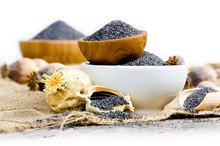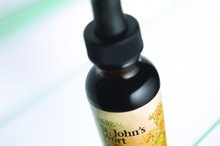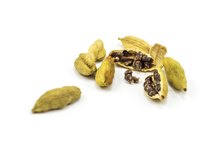Tiger Balm Ingredients
Tiger Balm is a topical pain reliever made from herbal and plant-based sources. It is promoted as a remedy for joint and muscle pain associated with arthritis and minor injury, as well as headaches and muscle tension. There are many different Tiger Balm products, including ointments, liniments, creams and sprays, all of which contain slightly different formulas and are indicated for specific uses. Despite these differences, most Tiger Balm products contain the same base ingredients that are included for their anesthetic and analgesic properties.
Menthol
Menthol is a compound with analgesic effects. It occurs naturally in peppermint and is a popular ingredient in over-the-counter pain-relief ointments like Tiger Balm. According to MedlinePlus, the online health information resource maintained by the U.S. National Library of Medicine and the National Institutes of Health, menthol targets kappa-opioid receptors in the brain, resulting in temporary relief from minor pain. The cool sensation that occurs when menthol is applied topically stems from its stimulation of “cold” receptors that regulate the perception of cold temperatures.
- Menthol is a compound with analgesic effects.
- The cool sensation that occurs when menthol is applied topically stems from its stimulation of “cold” receptors that regulate the perception of cold temperatures.
Camphor
3 Essential Oils to Reduce Tooth Pain
Learn More
Camphor is a strong-smelling compound derived from the camphor laurel tree. It has decongestant and analgesic properties, making it a popular ingredient in vapor rub products, over-the-counter nasal inhalers and topical painkillers like Tiger Balm. According to the Journal of Neuroscience, camphor works by desensitizing the vanilloid receptor, which plays a role in the brain's detection of pain-causing stimuli.
Mint Oil
Mint oil is a soothing substance extracted from herbs in the mint family, such as peppermint and spearmint. While mint tea is often taken internally to treat stomach pain and discomfort, the essential oil may be applied topically for its painkilling effects. Mint oil contains between 40 and 90 percent menthol, making it an effective natural analgesic.
Cajuput Oil
Herbal Alternatives to Hydrocodone
Learn More
Derived from the leaves of the Melaleuca leucadendra tree, cajuput oil is a pungent-smelling volatile oil with potent painkilling properties. Applied topically, cajuput oil acts as a counterirritant, distracting the brain from the underlying source of pain. Capsaicin—a more well-known natural pain reliever—works in a similar manner.
Clove Bud Oil
Used for centuries in Indonesia, clove bud oil is an effective topical pain reliever. It contains eugenol, a compound with anti-inflammatory; numbing, or anesthetic; and painkilling effects. According to MedlinePlus, clove bud oil may be as effective as benzocaine in relieving dental pain and is approved for use as a topical analgesic by Germany's Commission E, an official government agency that performs a job similar to that of the U.S. Food and Drug Administration, but it focuses only on herbs.
Carrier Oils
Carrier oils are inert substances added to Tiger Balm to dilute the product and give it texture. Paraffin and petroleum jelly are the main carrier oils in Tiger Balm products. Unlike many other topical creams and ointments, Tiger Balm contains no animal-based ingredients.
Related Articles
References
- Journal of Neuroscience: Camphor Activates and Strongly Desensitizes the Transient Receptor Potential Vanilloid Subtype 1 Channel in a Vanilloid-Independent Mechanism
- Tiger Balm. Tigerbalm.com
- Pickett, Mallory. What’s Inside Tiger Balm? Hint: Not Actual Tigers. wired.com March 8, 2017
- Kotaka T, Kimura S, Kashiwayanagi M, Iwamoto J. Camphor induces cold and warm sensations with increases in skin and muscle blood flow in human. Biol Pharm Bull. 2014;37(12):1913-8.
- Amato A, Liotta R, Mulè F. Effects of menthol on circular smooth muscle of human colon: analysis of the mechanism of action. Eur J Pharmacol. 2014;740:295-301.
- Pannee C, Chandhanee I, Wacharee L. Antiinflammatory effects of essential oil from the leaves of Cinnamomum cassia and cinnamaldehyde on lipopolysaccharide-stimulated J774A.1 cells. J Adv Pharm Technol Res. 2014;5(4):164-70.
- Schattner P, Randerson D. Tiger Balm as a treatment of tension headache. A clinical trial in general practice. Aust Fam Physician. 1996;25(2):216, 218, 220 passim.
- Haw C, Wolstencroft L. A study of the prescription and administration of sedative PRN medication to older adults at a secure hospital. Int Psychogeriatr. 2014;26(6):943-51.
- Johnson CR, Porter SG, Coats D, et al. No camphor toxicity in Cambodian Infants. Glob Pediatr Health. 2017;4:2333794X17702980. doi:10.1177/2333794X17702980.
- Tiger Balm UK. History of Tiger Balm.
Resources
Writer Bio
Based in Las Vegas, Tracii Hanes is a freelance writer specializing in health and psychology with over seven years of professional experience. She got her start as a news reporter and has since focused exclusively on freelance writing, contributing to websites like Wellsphere, Education Portal and more. She holds a Bachelor of Arts in communication arts from Southwestern Oklahoma State University.









